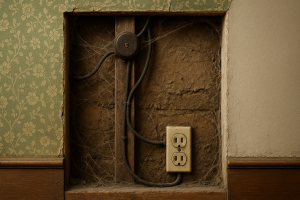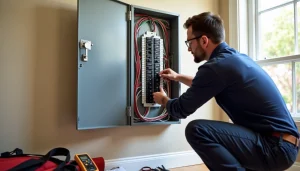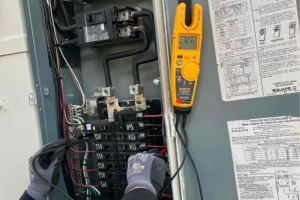Electrical fires rank among the top causes of home fires. Your home and life could depend on knowing the key differences between AFCI vs GFCI protection. These safety devices work differently. GFCIs keep you safe from deadly electric shock. They detect tiny current differences of 4-6 milliamps, especially in bathrooms and kitchens where water is present. AFCIs take a different approach by stopping electrical fires. They spot dangerous arc faults in your home’s wiring.
Choosing between AFCI and GFCI becomes especially important based on where you need protection. Both improve electrical safety but deal with different risks. The main difference lies in how they protect – arc fault vs ground fault protection. The National Fire Protection Association has recognized AFCIs’ effectiveness since 1999. These devices can detect parallel and series arc faults that might ignite flammable materials. The National Electrical Code now requires specific protection in different parts of your home. This makes it vital to understand when to use AFCI vs GFCI. Dual-function breakers offer the best solution by combining both technologies. They reduce the risks of electrical fires and electrocution by a lot throughout your home.
How GFCI Devices Prevent Electric Shock
Ground Fault Circuit Interrupters (GFCIs) protect you from deadly electric shocks. These safety devices work differently from standard outlets by monitoring electricity flow and cutting off power automatically during dangerous situations.
GFCI Receptacle vs GFCI Breaker Explained
GFCIs come in two main types—receptacles and breakers—that protect you in different ways. GFCI receptacles replace your regular wall outlets and protect at the device level. You can spot these outlets by their “TEST” and “RESET” buttons on the faceplate.
GFCI breakers fit right into your electrical panel and protect entire circuits. A single GFCI breaker keeps all outlets, lighting fixtures, and appliances on that circuit safe. Receptacles give you local protection with easy reset access, while breakers provide detailed protection across multiple points.
The price tag often helps people decide—GFCI receptacles cost about $15 each, making them cheaper for protecting single points. GFCI breakers cost roughly ten times more but protect several outlets at once.
How GFCI Detects Ground Faults in Wet Areas
GFCI technology’s brilliance lies in its monitoring system. These devices track electricity as it flows in and out of equipment through circuit conductors. The GFCI immediately cuts power if the outgoing current is different from the returning current by about 5 milliamperes.
This response happens in just 1/40 of a second. Such quick action stops electrical current from flowing through water or your body long enough to cause harm.
Wet areas pose extra danger because water conducts electricity well. A GFCI cuts power before you get a severe shock if an appliance with damaged wiring touches water and electricity tries to flow through your body.
Common Locations for GFCI Installation
The National Electrical Code (NEC) requires GFCI protection where water and electricity might meet:
- Bathrooms: All bathroom receptacles since 1975
- Kitchens: All 15-amp, 20-amp, and 125-volt outlets near countertops
- Outdoor areas: All outdoor outlets, especially within 20 feet of pools
- Garages: Areas with running water need special attention
- Laundry rooms: Outlets within six feet of sinks and washing machines
- Basements: All unfinished spaces and crawl spaces
The Electrical Safety Foundation International reports that about 44 million American homes still need proper GFCI protection in wet areas. Proper GFCI installation could prevent more than 47% of electrocutions.
Testing and Resetting a GFCI Outlet
Your GFCIs need monthly testing to stay reliable. Here’s how to test a GFCI outlet:
Start by pressing the “Reset” button to ensure normal operation. Plug in a lamp or small appliance and turn it on. Press the “Test” button—your device should turn off right away. Press “Reset” to restore power—your device should work again.
Your GFCI needs immediate replacement if the device stays on after pressing “Test”. These devices usually last about 10 years before needing replacement.
A tripped GFCI works better if you unplug everything before resetting it. This helps find what caused the problem. Check your breaker panel if the reset doesn’t work since the whole circuit might be affected. Frequent trips usually mean you have a faulty appliance or moisture inside the outlet.
Understanding AFCI and Arc Fault Protection
Arc faults are among the most dangerous electrical hazards in your home. They can generate temperatures that reach over 10,000 degrees Fahrenheit. These intense heat sources can quickly ignite nearby materials like wood framing or insulation. The danger multiplies because they often start in hidden areas where smoke alarms can’t detect them until it’s too late.
What Causes an Arc Fault in Home Wiring
An arc fault happens when electrical current jumps or “arcs” across a circuit gap. Here are the common conditions that create these dangerous situations:
- Damaged wiring insulation exposing conductors
- Loose or corroded connections between wires and terminals
- Wires improperly nailed or stapled too tight against wall studs
- Excessive bending or flexing of electrical cables
- Rodent damage or moisture exposure
- Natural aging of electrical components
The Consumer Product Safety Commission reports that proper Arc-Fault Circuit Interrupter (AFCI) protection could prevent more than 50% of electrical fires. The risk of dangerous arcing becomes higher as electrical components age.
Series vs Parallel Arc Faults
You need to know the difference between series and parallel arc faults to ensure proper protection:
Series Arc Faults happen within a single conductor due to a break or weak connection. Common causes include:
- Broken wires within the same conductor
- Loose connections at terminals or outlets
- Worn electrical insulation
Series arcs produce less current than parallel arcs but generate enough heat to start fires. The circuit’s load limits the current in a series arc.
Parallel Arc Faults happen when electricity jumps between different conductors—usually between hot and neutral wires, or between a hot wire and ground. These are more dangerous because:
- They draw current up to the available short-circuit current at the fault spot
- Their sparks produce more energy
- Hot metal can eject and touch flammable materials
How AFCI Breakers Detect Dangerous Arcs
AFCI breakers use advanced electronics to tell harmless arcs from dangerous ones. They constantly watch electrical waveforms for specific patterns that signal hazardous conditions.
The detection works by:
- Looking for unique “signatures” in electrical current
- Checking frequency and amplitude changes in the 60-cycle-per-second waveform
- Telling normal arcs (like those in motors) from dangerous ones
- Finding parallel arcs, series arcs, or both based on the AFCI type
AFCI breakers cut power in a fraction of a second once they spot a dangerous arc pattern. This happens before the arc can create enough heat to cause a fire.
AFCI Receptacle vs Breaker: Key Differences
AFCIs come in breaker and receptacle forms like GFCIs. Each type has its benefits:
AFCI Circuit Breakers:
- Go right into the electrical panel
- Guard the entire circuit and in-wall wiring
- Give more complete protection
- Need to match your electrical panel
- Cost more than receptacles
AFCI Receptacles:
- Go in the first outlet of a branch circuit
- Guard all outlets and devices downstream
- Make installation easier in existing homes
- Cost about $30, less than breakers
- May not protect wiring between panel and first outlet without specific conditions
Modern combination-type AFCIs (since 2008) catch both series and parallel arcs. This means better fire safety than older models.
AFCI vs GFCI: The Critical Differences
You need to understand the differences between AFCI and GFCI protection to make smart choices about electrical safety in your home. These devices offer better protection than standard circuit breakers, but they protect against different electrical hazards.
Arc Fault vs Ground Fault: What’s the Difference?
An arc fault happens when electrical current “jumps” or arcs between damaged parts of a conductor or between multiple conductors. This usually occurs with damaged wires or bad connections that put nearby combustible materials at risk. A ground fault is a type of short circuit that happens when a hot wire touches a grounded part of an electrical system that shouldn’t have power, like an appliance housing or electrical box. Ground faults can create dangerous paths through the human body, while arc faults mainly threaten property.
Protection Focus: Fire vs Shock
The main difference lies in how they protect you. AFCIs protect your home from fires. They watch electricity flow and cut power right away when they detect unwanted arcing patterns. GFCIs protect people from electrical shock. They detect when current leaves the circuit—even tiny amounts like 4-6 milliamps, which is less than the lethal 10 milliamps. This explains why you’ll find them in different places throughout your home.
When to Use AFCI vs GFCI in Your Home
| Location | AFCI | GFCI |
|---|---|---|
| Bedrooms | Required | Not typically required |
| Living Areas | Required | Not typically required |
| Kitchens | Required | Required (near water sources) |
| Bathrooms | Not required | Required |
| Outdoor Areas | Not required | Required |
| Garages | Not required | Required |
| Basements | Partially required | Required for unfinished areas |
Dual-function breakers that combine both technologies are becoming popular choices to protect kitchens and laundry areas.
Code Requirements for AFCI and GFCI by Room
The National Electrical Code (NEC) has expanded AFCI requirements by a lot. Recent updates require AFCI protection in almost every room of new homes. This includes bedrooms, living rooms, dining rooms, kitchens, laundry rooms, hallways, and closets. Bathrooms and garages are the only rooms that don’t need AFCI protection.
GFCI protection is needed where water and electricity might mix: bathrooms, kitchens (all outlets as of 2023 NEC), outdoor areas, garages, unfinished basements, laundry areas, and within 6 feet of sinks. The 2023 NEC now requires GFCI protection for electric ranges, wall-mounted ovens, counter-mounted cooking units, clothes dryers, and microwave ovens.
Your local building codes might have extra requirements beyond these national standards. Check with your local code authority before you start any electrical work.
Dual-Function Breakers: Combining AFCI and GFCI
Dual-function breakers mark the latest progress in home safety technology and provide the best protection for your electrical system. These advanced devices combine AFCI and GFCI protection into one unit.
What is a CAFCI Breaker?
Combination Arc Fault Circuit Interrupters (CAFCI) detect parallel and series arc faults in your electrical system. Standard AFCIs only catch parallel arcs between different conductors. CAFCIs go further by detecting series arcs within a single wire. Series arcs happen when electricity jumps across breaks or weak connections in the same conductor. CAFCI breakers give you the best arc fault protection you can get right now. They protect the entire circuit from both types of dangerous arcing.
Benefits of Dual-Function Protection
Dual-function AFCI/GFCI breakers beat installing separate protective devices in several ways:
Cost Efficiency: These breakers cost about $60 compared to $50 for AFCI-only models. You save money because you don’t need separate GFCI outlets.
Simplified Installation: A single dual-function breaker in your electrical panel protects the whole circuit from arc and ground faults. This eliminates the need for multiple protective devices throughout your home.
Centralized Reset Location: You only need to check your electrical panel when a protective device trips. No more searching for tripped GFCI outlets behind furniture or appliances.
Complete Protection: These breakers protect your entire circuit. This includes the “home run” wiring between your electrical panel and first outlet – about 30% of your home’s wiring that outlet-based protection misses.
Limitations and Nuisance Tripping Issues
Dual-function breakers have their drawbacks. The biggest issue is “nuisance tripping” – power shutoffs when no real danger exists. This happens because the sophisticated electronics sometimes mistake normal electrical patterns from certain appliances for dangerous arcing.
Smart breakers with WiFi or Bluetooth capabilities now help address this issue. They can get firmware updates to recognize new appliance patterns and reduce false trips. Yet nuisance tripping remains contractors’ top complaint when installing these devices.
High-powered appliances like refrigerators pose another challenge. Food can spoil if the breaker trips while you’re away. You should think over whether dual-function protection makes sense in these situations.
Installation and Maintenance Tips for Homeowners
Your AFCI and GFCI devices protect your home best when properly installed and maintained regularly. These guidelines will help you maximize fire and shock protection across your electrical system.
How to Wire a GFCI or AFCI Outlet Safely
Power must be off at the circuit breaker before starting any electrical work – verify this with a voltage tester. The difference between LINE (power source) and LOAD (downstream) wires is crucial to proper protection. To install GFCI outlets:
- Connect LINE wires to LINE terminals (white wire to silver terminal, black wire to brass terminal)
- Connect LOAD wires to LOAD terminals (after removing yellow sticker)
- Connect ground wire to the grounding terminal
AFCI outlets must be installed at the circuit’s first outlet to protect downstream connections. Make sure to fold wires carefully into the box and keep ground wires away from hot and neutral terminals.
Monthly Testing Recommendations
Both AFCI and GFCI devices should be tested monthly according to manufacturers. This quick routine takes seconds and could save lives:
For GFCI testing:
- Press the RESET button first
- Plug in a lamp and verify it works
- Press the TEST button—the lamp should turn off
- Press RESET—the lamp should turn back on
For AFCI testing:
- Keep one device powered on the circuit
- Press the TEST button on the breaker
- Verify the breaker trips to the OFF position
- Reset the breaker completely OFF before turning back ON
Schedule these tests during weekday mornings when electricians are available if replacement becomes necessary.
Signs Your Breaker or Outlet Needs Replacement
Your AFCI or GFCI device needs immediate replacement if you notice:
- Outlet TEST button doesn’t trip when pressed
- Breaker trips but doesn’t cut power completely
- Outlet won’t RESET after tripping
- Plug slots are worn out and plugs fall out easily
- Crackling sounds come from outlets
- Outlets are over 10 years old
- Newer breaker models show six LED blinks (suggesting self-test failure)
- Nuisance tripping happens often with no clear cause
These protective devices need periodic testing and replacement to maintain their life-saving capabilities.
Conclusion
Why Both AFCI and GFCI Protection Matter for Complete Home Safety
This piece has shown how AFCI and GFCI devices play different but complementary roles in safety. GFCIs excel at preventing deadly electric shocks, especially near water sources. AFCIs focus on preventing electrical fires by detecting dangerous arc faults before they can ignite materials nearby.
Safety statistics paint a clear picture of why these protections matter. The Electrical Safety Foundation International shows that proper GFCI installation could prevent almost half of home electrocutions. The Consumer Product Safety Commission’s data proves that AFCIs could stop more than 50% of electrical fires. These numbers show just how much these devices can save lives.
The electrical code requirements might look complex at first. But knowing where each protection belongs will give your home more than just basic safety standards. You need GFCI protection in bathrooms, kitchens, and outdoor areas because of water exposure. Bedrooms, living spaces, and hallways need AFCI protection to prevent fires.
Dual-function breakers are perfect for spaces that need both types of protection. These combination devices cost more upfront but protect entire circuits from both shock and fire hazards. You won’t need multiple devices, and even the wiring inside your walls stays protected.
It’s worth mentioning that electrical safety devices need regular testing and replacement. Testing takes just seconds each month but makes your family much safer. On top of that, it’s crucial to replace any device that fails testing or is about ten years old.
Electrical safety is an investment in your home and family’s future. Whether you’re fixing up an old house or building a new one, the right AFCI and GFCI protection could save your property—and more importantly—save lives.





